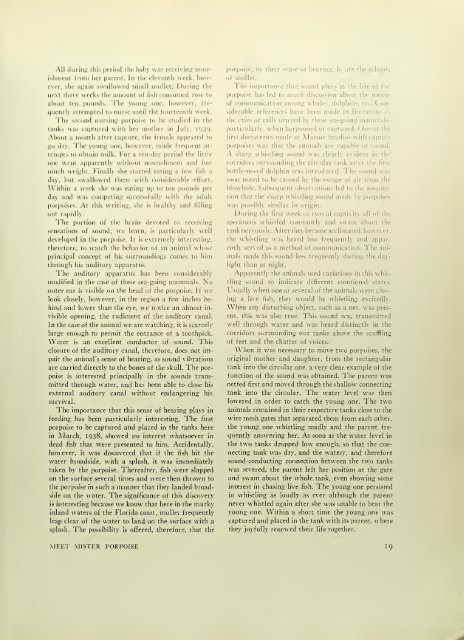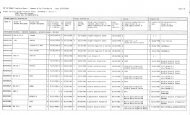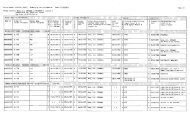Meet Mr. Porpoise - Ceta-Base
Meet Mr. Porpoise - Ceta-Base
Meet Mr. Porpoise - Ceta-Base
Create successful ePaper yourself
Turn your PDF publications into a flip-book with our unique Google optimized e-Paper software.
All during rliis period the babj was receiving nourishment<br />
from her parent. In the eleventh week, how-<br />
ever, she again swallowed small mullet. During tin-<br />
next three weeks the amount of fish consumed rose to<br />
about ten pounds. The young one, however, fre-<br />
quently attempted to nurse until the fourteenth week.<br />
The second nursing porpoise to be studied in the<br />
tanks was captured with her mother in July, 1939.<br />
About a month after capture, the female appeared to<br />
go dry. The young one, however, made frequent at-<br />
tempts to obtain milk. For a ten-day period the little<br />
one went apparently without nourishment and lust<br />
much weight. Finally she started eating a few fisb a<br />
day, but swallowed them with considerable effort.<br />
Within a week she was eating up to ten pounds per<br />
day and was competing successfully with the adult<br />
porpoises. At this writing, she is healthy and filling<br />
out rapidly.<br />
The portion of the brain devoted to receiving<br />
sensations of sound, we learn, is particularly well<br />
developed in the porpoise. It is extremely interesting,<br />
therefore, to watch the behavior of an animal whose<br />
principal concept of his surroundings comes to him<br />
through his auditory apparatus.<br />
The auditory apparatus has been considerably<br />
modified in the case of these sea-going mammals. No<br />
outer ear is visible on the head of the porpoise. If we<br />
look closely, however, in the region a few inches be-<br />
hind and lower than the eye, we notice an almost in-<br />
visible opening, the rudiment of the auditory canal.<br />
In the case of the animal we are watching, it is scarcely<br />
large enough to permit the entrance of a toothpick.<br />
Water is an excellent conductor of sound. This<br />
closure of the auditory canal, therefore, does not im-<br />
pair the animal's sense of hearing, as sound vibrations<br />
are carried directly to the bones of the skull. The por-<br />
poise is interested principally in the sounds trans-<br />
mitted through water, and has been able to close his<br />
external auditory canal without endangering his<br />
survival.<br />
The importance that this sense of hearing plays in<br />
feeding has been particularly interesting. The first<br />
porpoise to be captured and placed in the tanks here<br />
in March, 1938, showed no interest whatsoever in<br />
dead fish that were presented to him. Accidentally,<br />
however, it was discovered that if the fish hit the<br />
water broadside, with a splash, it was immediately<br />
taken by the porpoise. Thereafter, fish were slapped<br />
on the surface several times and were then thrown to<br />
the porpoise in such a manner that they landed broad-<br />
side on the water. The significance of this discovery<br />
is interesting because we know that here in the murky<br />
inland waters of the Florida coast, mullet frequently<br />
leap clear of the water to land on the surface with a<br />
splash. The possibility is offered, therefore, that the<br />
J let.<br />
The importance that sound plays in the life<br />
porpoise lias ] (-d to much discussion about the<br />
of communication among whales, dolph<br />
siderable reference- have been made in literature to<br />
or calls uttered bj ing mammals.<br />
particularly, when harpooned oi<br />
OVeries made at Marine Studio- with<br />
porpoises was that the animals are capa<br />
A sharp whistling sound was clearly evident in the<br />
corridors surrounding the circular tank after the first<br />
bottle-nosed dolphin was introduced. The sound was<br />
-0011 noted to be caused by the 1 air from the<br />
blowhole. Subsequent observations led to the :<br />
tion that the sharp whistling sound made by porpoises<br />
was possiblj similar in origin.<br />
During the first week or two of captivity all of the<br />
specimens whistled constantlj and swam about the<br />
tank nervously. Afterthey became acclimated, bow ever,<br />
the whistling was heard less frequently and appar-<br />
ent [j served as a method of communication. I<br />
mals made this sound less frequently during the day-<br />
light than at night.<br />
Apparently the animals used variations in this whis-<br />
tling sound to indicate different emotional states.<br />
L sually when one or several of the animals w ere chas-<br />
ing a live fish, they would be whistling excitedly.<br />
When any disturbing object, such as a net. was pres-<br />
ent, this was also true. This sound was transmitted<br />
well through water and was heard distinctly in the<br />
corridors surrounding our tanks above the scuffling<br />
of feet and the chatter of voices.<br />
A\ hen it was necessary to move two porpoises, the<br />
original mother and daughter, from the rectangular<br />
tank into the circular one, a very clear example of the<br />
function of the sound was obtained. The parent was<br />
netted first and moved through the shallow connecting<br />
tank into the circular. The water level was then<br />
lowered in order to catch the young one. The two<br />
animals remained in their respective tanks close to the<br />
wire mesh gates that separated them from each other,<br />
the young one whistling madly and the parent fre-<br />
quently answering her. As soon as the water level in<br />
the two tanks dropped low enough, so that the con-<br />
necting tank was dry, and the watery, and therefore<br />
sound-conducting connection between the two tanks<br />
was severed, the parent left her position at the gate<br />
and swam about the whole tank, even showing some<br />
interest in chasing live fish. The young one persisted<br />
in whistling as loudly as ever although the parent<br />
never whistled again after she was unable to hear the<br />
young one. Within a short time the young one was<br />
captured and placed in the tank with its parent, where<br />
they joyfully renewed their life together.<br />
MEET MISTER PORPOISE J 9











